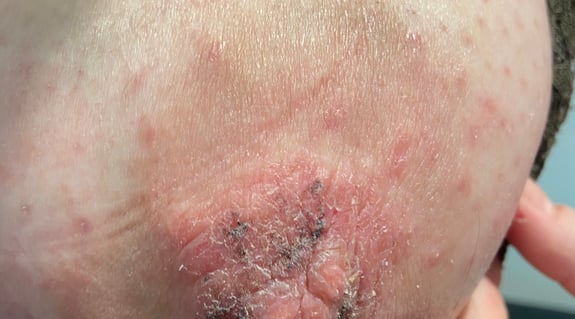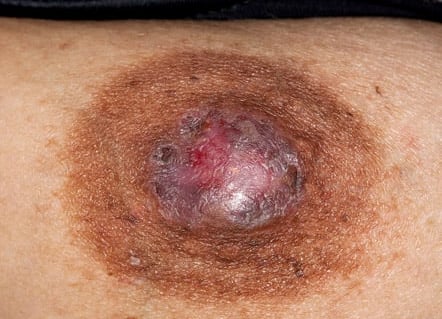4 professionals
Maria, 65 years old. Concerning lesion on the nipple.
Maria, 65 years old. Concerning lesion on the nipple.
Related topics
Maria, age 65, with no known history of any particular pathologies, visits her doctor with a pruritic lesion on her left nipple, which has been progressively developing over the past year, spreading from the nipple towards the areola.

The lesion is erythematous, weeping, slightly scaly, and infiltrative. There was no serosanguineous drainage from the nipple or any other discharge.
Breast palpation found no underlying mass and no satellite adenopathies.

True answer!
Wrong answer!
True answer!
Wrong answer!
True answer!
Wrong answer!
When the test results come back, the diagnosis of eczema is confirmed.
An essential clinical sign is that Paget’s disease affects the entire nipple-areolar complex, whereas an erythema that spares the nipple is not Paget’s disease.
Anatomo-pathological examination of the skin biopsy revealed invasion of the nipple epidermis by lesions of ductal carcinoma in situ, with the presence of Paget cells in the nipple epidermis.
We can point to two potential mechanisms:

Shows centrifugal progression from nipple to areola.
Erythematous, weeping lesion of the nipple, often thickened, rough, and scaly. Its surface may be erosive, with ulceration and an indurated crust with a clear boundary. There is progressive loss of nipple definition. Patients frequently report pain, burning, or itching of the nipple. During the breast exam, you should look for serosanguineous drainage from the nipple, an underlying mass, and/or adenopathy. Transient improvements have been described and should not rule out the diagnosis.
It is sometimes associated with vulvar Paget’s disease.
Paget’s disease of the nipple, although rare, should be suspected in the presence of any persistent eczematous lesion of the nipple that has not responded to medical treatment.
Diagnostic certainty requires histological comparison. The pairing of a mammogram and ultrasound of the breast, potentially with a breast MRI, should be used to look for underlying breast cancer and guide surgical treatment.
The prognosis for Paget’s disease of the nipple depends on the presence of an associated palpable mass and the invasiveness of the underlying cancer.
Eczema of the nipple-areolar region is particularly linked to atopy.
The affected area is generally bilateral, very pruritic, with no deformation of the nipple. The lesions are poorly defined, with diffuse contours, no scabbing, and no real ulceration, and develop relatively quickly, unlike Paget’s disease.
The disease progresses in flare-ups interspersed with periods of remission. Sometimes the lesions are chronic and lichenified.
Other locations are associated, particularly in the skin folds.
Once a diagnosis of eczema has been made, it is not necessary to carry out a breast examination, but in the case of a chronic and unilateral affliction, Paget’s disease must be ruled out with a biopsy.

True answer!
Wrong answer!
True answer!
Wrong answer!
True answer!
Wrong answer!
True answer!
Wrong answer!

Schedule/refer the patient for biopsy in cases of chronic or atypical eczema of the nipple to rule out Paget’s disease.

Eczema is unilateral, insidious, and affects the entire nipple-areolar complex.
Critical point: biopsy and ultrasound should be considered.

Midwives take part in the initial clinical examination and in prescribing additional tests.
Organising coordination with the GP to arrange an appointment with a dermatologist as quickly as possible, and liaising with one of the gynaecologist referral doctors within the midwife’s network.

Biopsy is only useful after trial treatment has failed, never as1st-line treatment.
If a biopsy is to be carried out, it must go deep.
1st line: monitoring and trial treatment.
If persistent lesion is highly.
Create easily your professional account
I create my accountGet access to exclusive dermatological services to increase your professionnal knowledge: +500 pathology visuals, clinical cases, expert videos
Benefit from valuable features: audio listening, materials to be shared with your patients
Stay informed about the upcoming events and webinars, latest scientific publications and product innovations